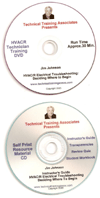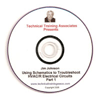“The Advanced Energy Design Guide [AEDG] series represents the best practices in industry for energy efficiency in buildings,” said Shanti Pless, NREL senior research engineer and AEDG project chair. “Our job is to develop those best practices, along with the professionals in the industry, and put them together in an easy-to-implement guide. NREL created the modeling and optimization software used to determine that what is going into the guides achieves a 50 percent savings goal.”
The NREL commercial buildings team of Pless, Eric Bonnema, and Matt Leach led the development of the Large Hospital, Retail, and School 50 percent savings AEDGs. Pless was chair of the project committees of industry experts, and Bonnema and Leach provided efficiency expertise and energy modeling optimization support.
U.S. hospitals spend more than $5 billion annually on energy, often equaling 1 percent to 3 percent of a typical hospital’s operating budget. “Health care is a big opportunity for energy savings,” Pless said. “We felt this industry needed resources, and there weren’t many out there helping them to achieve 50 percent savings in energy.”
The 50 percent AEDG series is a new group of publications that builds on previous work. The collaborating organizations published a series of six 30 percent AEDGs covering structures ranging from small office buildings to highway lodging to self-storage buildings. Between the 30 percent and 50 percent AEDGs, there are roughly 450,000 copies currently in circulation. The full series of AEDGs is available for free download at www.ashrae.org/aedg.
But Don't Just Follow Code
The building code is the baseline for the least energy-efficient building an owner can construct. Fortunately, there is nothing in building codes to stop building owners and construction companies who want to go for the most energy savings they can find — and that’s where the AEDGs can bridge the gap.
“There is a lot of interest out there for 50 percent energy savings in buildings because just about anyone can do it, if they are paying attention,” Pless said. “And it doesn’t have to cost more if you are using streamlined design and construction processes.”
The AEDGs are written for owners, design teams, and contractors. If they don’t have experience in energy efficiency, they can look to these guides for examples and details. The guides have recommendation tables for all climate zones in the United States.
AEDG recommendations are also built on technical support documents written by the national labs that accompany the design guides. These support documents cover the details of the energy modeling used. For instance, while daylighting works well in almost all climate zones, heating and cooling can require different solutions from zone to zone, especially in hospitals because of the high demand for fresh air.
“Hospitals have strict ventilation requirements, and they bring in a certain amount of fresh air along with a certain amount of recirculated air,” Bonnema said. “There is a huge potential for savings if you set up your system differently, since most hospitals are using energy to cool the air and then heat it back up.”
Jeff Boldt is the director of engineering for KJWW Engineering Consultants, and he was also a project team member for the Large Hospital AEDG. “It’s really interesting when you look at a large hospital energy model; the biggest use of energy is the reheat. It’s because you have to dehumidify all the air. For instance, you cool it down to 52 degrees in order to dehumidify it. Then, your boiler comes on to reheat the air. That process is usually the single largest use of energy in a hospital. This guide figures out how to get that reheat for free or cause the reheat not to happen at all.”
According to Boldt, the AEDG will help the health care industry understand that there are practical ways to design a building that uses 50 percent less energy. “I like that they are prescriptive because a lot of people aren’t comfortable with energy modeling. With the AEDGs, we’ve done all the energy modeling, and you can hand this to your design team and say ‘I want you to follow the items in this AEDG,’ and your team can go from a checklist and know what they are getting.”
Running those energy models and finding climate-by-climate solutions wouldn’t be possible without the computer modeling muscle at NREL. “From our optimization tools to mass modeling capabilities using 16 climate zones and five building types, all running different ‘what if’ scenarios, we are able to do all the modeling on a pretty condensed timeline,” Pless said.
Schools Are Ahead of the Class
“Research has demonstrated that the quality of the physical environment affects student performance,” Pless said. “An environment that includes appropriate lighting, sound, temperature, humidity, and air quality can help students learn better. In many cases, improving these can also reduce energy use.”
Schools can have similar HVAC issues as hospitals — specifically, decoupling of ventilation air from space heating and cooling. If engineers are able to provide the heating and cooling separately from ventilation, this basically eliminates the issue of reheat in schools. The AEDG team has also produced a guide for K-12 Schools that includes:
• Three different HVAC system types that achieve significant energy savings.
• Different ways to daylight 100 percent of the floor area of classrooms, resource rooms, cafeterias, gymnasiums, and multipurpose rooms for two-thirds of school hours.
• Recommendations for computers, vending machines, kitchen cooking equipment, walk-in refrigeration equipment, kitchen exhaust hoods, and service water heating.
The K-12 Schools AEDG was one that NREL chose to do early on because a number of schools are at the 50 percent energy-savings level, and there were many case studies to draw from. Pete Jefferson, a principal with Denver-based M.E. GROUP, was on the project committee for the K-12 Schools AEDG. He said the guides give professionals a solid starting base for energy design.
“These guides are a great shortcut for anybody who is working on a school. You can jump to the AEDG recommendations and start from there and see how much further you can go as a design professional,” Jefferson said. “When we do our energy models, we use the AEDG recommendations as our new baseline to see how we can improve from there.”
Some schools are even pushing the envelope to net-zero energy levels — which is something the team hopes to tackle in the next round of design guides. A net-zero energy building is one in which annual on-site renewable energy production is equal to or greater than the building’s energy use.
“Net-zero makes a lot of sense for schools. They are built to last for 50 years, and a lot of effort goes into making them robust,” Pless said. “There are also teaching opportunities with energy-efficiency features and on-site renewables. So there are net-zero schools popping up, but having a design guide with best practices is key to helping them become widespread.”
The NREL team sees a need for a complete net-zero design guide series. “Industry is starting to understand that it can be done,” Pless said. “Having a net-zero office design guide is needed. There are examples across the country of offices that are attempting to do this.”
The United States adds 2 percent every year in new buildings and only tears down 1 percent, which means the nation continues to add to its energy use when it comes to buildings. The AEDG team sees the opportunity to make new buildings more energy efficient and sees even greater opportunities when it comes to energy efficiency retrofits, because the recommendations in the guides can apply to both.
“At these building rates, over the course of 20 years, you’ve touched over half of the buildings in America through retrofits or bringing new construction to 50 percent savings,” Pless said. “That’s measureable impact on the 40 percent of the nation’s energy that gets used in buildings.”
Another area where the AEDGs have had an impact is the town of Greensburg, Kan. After a 2007 tornado leveled nearly the entire town, DOE and NREL helped the town leaders create a newer, more efficient Greensburg. In this case, a whole town was constructed that was able to achieve 50 percent energy savings. “Greensburg was kind of a demonstration for us that if 50 percent energy savings can be done here, it can be done anywhere,” Pless said. “It exemplifies all the AEDG work that has been done.”
Sidebar: Industry and Government Partners
The Advanced Energy Design Guides (AEDGs) bring together professionals from industry and government. The guides are developed by:
American Society of Heating, Refrigerating and Air-Conditioning Engineers (ASHRAE)
American Institute of Architects (AIA)
Illuminating Engineering Society of North America (IESNA)
U.S. Green Building Council (USGBC)
U.S. Department of Energy (DOE)
National Renewable Energy Laboratory (NREL)
Pacific Northwest National Laboratory (PNNL)
To date, four 50 percent AEDGs and six 30 percent AEDGs have been published and are available for download at www.ashrae.org/aedg.
Publication date: 9/3/2012










